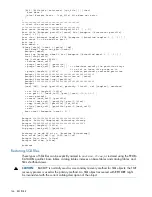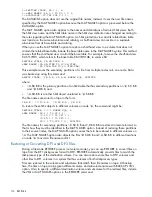
destinations. RESTORE restores each file to its original location. However, if you must restore files
to a different network, or if you must restore SQL objects to a new location, you might need to
perform name mapping.
The CATALOG[S] option is necessary with the MAP NAMES option if a different catalog is to be
used during RESTORE. A complete mapping scheme eliminates errors if AUTOCREATECATALOG
is OFF, and unexpected registration locations if it is ON.
CAUTION:
It is critical that the CATALOGS and MAP NAMES mapping lists are complete even
when recovering an individual partition:
•
If the CATALOGS option is specified, every associated catalog must be mapped.
•
If the MAP NAMES option is specified, every partition must be mapped.
If the maps are incomplete or incorrect, severe catalog inconsistencies for the object will result.
These inconsistencies are quite difficult to repair, so make sure to avoid them.
Restoring Files From Multiple Systems
If you try to restore a file set that originally existed on multiple system nodes, RESTORE searches
the current network for a system that matches the file node of any remote files on the BACKUP
tape.
If you are restoring to the system on which the files were backed up (or to another system on the
same network), you do not need to be concerned about the file names or destination for remote
files. RESTORE restores the remote files back to their original locations. Because the local files do
not contain the file node information, the local files will be restored on the system that is running
RESTORE.
Restoring Files to a Different Network
If you run RESTORE on a system that is not connected to the network where the BACKUP session
was run, several outcomes are possible:
•
If all the files on the BACKUP tape are in the local format, the files are restored to the local
system. For more information on backup formats, see
BACKUP Guidelines and Examples
(page 72)
.
•
If any files on the BACKUP tape are in the remote format, RESTORE attempts to restore the
files to the system that has the same system node number as the remote file. For example:
1.
Run RESTORE with the LISTONLY option:
RESTORE $TAPE, ( *.*.* ), LISTONLY
This lets you determine how node numbers and node names are correlated on the
destination network.
If the source node number exists in the destination network, the output from the LISTONLY
option displays the matching node name in the destination network. For example, the
files are listed as:
$VOL.SUBVOL
TInd1
\B.$VOL.SUBVOL
Table1
If the node number does not exist on the destination network, the node name is replaced
with "\??" in the output from the LISTONLY option. For example, the files are listed as:
$VOL.SUBVOL
TInd1
172
RESTORE
Содержание BACKCOPY
Страница 113: ...Format of the Permanent Work File 1 13 ...
Страница 114: ...1 14 Disk Space Analysis Program DSAP ...
















































